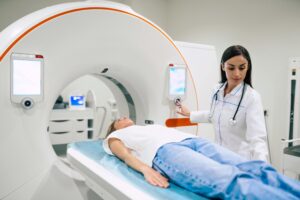Aim for a few minutes for one, and up to two hours for the other. Which test will yield the information required for your health issues is determined by your doctor or the members of your care team.
Computed Tomography (CT) Scans
One popular imaging method for providing fine-grained pictures of the inside of your body is a CT scan. This X-ray technology is displayed with a little quantity of radiation, with certain places highlighted using contrasting material.
Your body’s inside is seen in two dimensions by the X-ray with the use of a computer. A CT scan may be finished in as little as five minutes and is entirely painless. During the scan, many body views are captured by the CT scanner.
Why Physicians Order A CT Scan
A CT scan will diagnose many health conditions. They include: cancer cells, infections, chronic vascular conditions, and injuries like fractured bones. They can show blood vessels, organs, and soft tissues. It is possible to locate the size and location of tumors, blood clots, heart disease, a liver mass, and internal bleeding.
a liver mass, and internal bleeding.
Your doctor may want to check for abnormalities in your brain, neck, spine, chest, or abdomen. It allows physicians to make critical medical decisions quickly and is used in many hospitals for a timely diagnosis since the results are immediate.
Positron Emission Tomography (PET) Scans
A low quantity of radiation is utilized with this kind of imaging device to emphasize the three-dimensional pictures; nevertheless, the test can take up to two hours. It is a type of imaging used in nuclear medicine.
It uses molecular pictures of the body to identify diseases and track their course. They can track the evolution of diseases and are most frequently used to identify them sooner than other testing. A little dose of a radioactive tracer is administered via the abdomen. It takes the tracer around an hour before the scan to highlight cancer cells, tumors, and inflammatory regions.
Why Physicians Order A PET Scan
A PET scan can diagnose:
- Cancer and heart disease
- Brain disorders like Alzheimer’s disease, Huntington’s disease, and seizures
- Cancer at an early stage
- Disorders of the central nervous system
- Blood sugar, blood flow, and oxygen use
- An organ that might not be functioning correctly
A PET scan can take two days to get results.
Main Differences
Materials: PET employs radioactive materials; CT uses X-rays that are passed through the body.
Different Timing: PET can take up to four hours, whereas CT can take minutes.
Radiation: a PET scan leaves a little quantity of radiation in the body, but a CT scan leaves no radiation in the body.
Cancer detection: Early identification of cancer can be achieved via PET scans.
Contact Southwest Diagnostic Imaging Center at (214) 345-6905 if you have additional questions concerning CT vs PET scans or if you’d like to schedule a scan at our Dallas imaging center.

